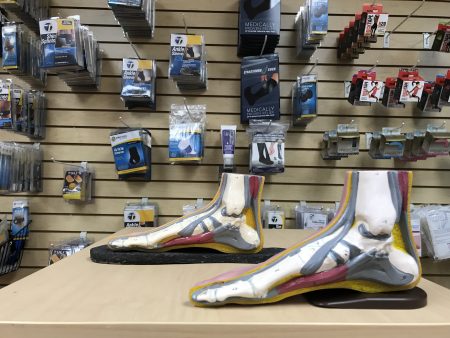Follow these simple steps to order your full-length lifts. The full-length lifts are $50 plus shipping and will typically ship less than a week following receipt of your payment.
Email info@sdri.net with your
- Shoe size and type (running shoe, dress shoe, cleat, etc.)
- Body weight
- The difference between your right and left leg or the height you desire the lift to be and which side (right or left) you want the lift for.
- Specify how many full-length lifts you want to purchase and any special instructions or questions.
Within 24 hours of your email an electronic invoice will be sent to you. Upon receipt of payment your full-length lifts will be made and ship within a week.
Please read below if you have questions about leg length discrepancy or the difference between heel lifts and full-length lifts.
What is a leg length discrepancy?
A Leg Length Inequality or Leg Length Discrepancy is exactly as it sounds. One or more bones (the Femur or thigh bone, the Tibia or shin bone, and/or the joint spacing within the knee) are unequal in total length when measured in comparison to the same structures on the opposite side. It is common for people to have one leg longer than the other. In fact, it is more typical to be asymmetrical than it is to be symmetrical.

Leg length discrepancy can be measured
How do I fix my leg length difference? Do I need surgery?
Surgery is not normally used to correct leg length discrepancies. There are a few methods that are used but the most common is a lift that is worn in the shoe of the shorter leg side. The lift has the effect of raising the short side up which puts the patients right and left sides into balance. There are 2 types of lifts used. Heel lifts and full length (heel to toe) lifts. For reasons that are described below full-length lifts are preferred.

Heel lifts transfer weight to the ball of the foot
Do I need a heel lift to correct my leg length discrepancy?
Heel lifts have the effect of raising the short leg side to provide balance between the patients long and short side. Unfortunately, it also has a similar effect that a high heeled shoe has. The heel lift will transfer weight from the heel towards the ball of the foot. This will put more pressure on the metatarsal region (ball of foot) and may result in other injuries such as metatarsalgia or knee pain. Heel lifts are often hard and uncomfortable and can make the patient feel as if they are coming out of their shoe. For these reasons a full-length lift is preferred over a heel lift. Full length-lifts fit under your entire foot and distribute pressure evenly as well as raise the entire short side to be in balance without transferring weight from the heel to the ball of your foot.

Full-length lifts distribute pressure evenly across the bottom of your foot and raisie the entire short side
How do I purchase a full-length lift?
San Diego Running Institute custom makes full length lifts based on your specific leg length discrepancy, your body weight and your shoe type and size. This is important to ensure comfort and fit as well as effectiveness. Full-length lifts are $50 plus shipping. It is recommended that you purchase a full-length lift for each shoe you plan to wear or at the minimum one for your sport shoes and one for your most commonly worn dress shoe. Follow these simple steps to order your full-length lifts. The full-length lifts will typically ship less than a week following receipt of your payment.
Email info@sdri.net with your
- Shoe size and type (running shoe, dress shoe, cleat, etc.)
- Body weight
- The difference between your right and left leg or the height you desire the lift to be.
- Specify how many full-length lifts you want to purchase and any special instructions or questions.
Within 24 hours of your email an electronic invoice will be sent to you. Upon receipt of payment your full-length lifts will be made and ship within a week.
If you require more information please email info@sdri.net or call 858-268-8525 to schedule an appointment.
If you want more information on Leg Length Discrepancy (LLD) click here
The medical information on this site is provided as an information resource only, and is not to be used or relied on for any diagnostic or treatment purposes. This information is not intended to be patient education, does not create any patient-physician relationship, and should not be used as a substitute for professional diagnosis and treatment.
